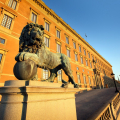ROYAL PALACE OF STOCKHOLM (KUNGLIGA SLOTTET)
An inside look at the history of the monarchy that preceded it, as well as the history of the current parliamentary monarchy.
The Royal Palace (Kungliga Slottet) is the official residence of the royal family in Stockholm, a baroque building designed by the architect Nicodemus Tessin the Younger that includes more than 600 rooms. In addition to the apartments, you can discover three history museums: the Castle Museum (Tre Kronor Museum), dedicated to the medieval history of the palace, the Treasury (Skattkammaren) and the Gustav IIIs antikmuseum (Gustav IIIs Antiquities Museum) with its ancient sculptures. Do not miss the changing of the guard at 12:15 pm from Monday to Saturday (1:15 pm on Sunday).
Built gradually, from a dungeon dating from the late twelfth century, Stockholm Castle has continued to grow over time. King Gustav I Vasa (1521-1560), founder of the modern Swedish state, is among those who strengthened the defense of the old castle. His son, John III Vasa (1569-1592), was more interested in the aesthetic aspect and had the austere medieval building remodeled in an opulent Renaissance style. During the 17th century, Tre Kronor, the name of the original tower, sometimes also used for the old castle, hardly contained the administrative services of a state that had become a great European power. King Charles XI (1660-1697) therefore commissioned the architect Nicodemus Tessin to expand the castle. The objective was to create a sumptuous residence worthy of the absolute monarch of Sweden. The north wing was built during the years 1692-1695 and, at the same time, the upper floor was converted into the reception rooms that can be seen today. On May 7, 1697, a fire broke out, destroying the old castle almost entirely. Only the newly built north wing was saved. Taking it as a starting point, Tessin devised a plan for a completely new palace. The reconstruction, which was rapid at first, was hampered by a lack of funds, as the wars of Charles XII (1697-1718) consumed all financial resources. Shortly before his death in 1728, Tessin was fortunate to have a special tax created to ensure the continuation of his work. The task of Nicodemus Tessin, as artistic and administrative head, fell to his son Charles-Gustave. But it was the architect Charles Hårleman who became the real director of the work. Although he followed Tessin's original plans faithfully, he applied the Rococo style of his time to the first floor apartments. In 1754, Adolph Frederick (1751-1771) and Louise Ulric were able to leave their temporary residence on the island of Riddarholmen and move into the royal palace, or more precisely into the lower part of the two large floors of the north wing, now called the Bernadotte Apartments. Their sons, Princes Gustav (III), Charles (XIII) and Frederick Adolph, successively received their own homes in the east and west wings. The castle, which had become a real palace, was completely fitted out around 1770.
The ceremonial room of Gustav III. The ceiling with its rich allegorical motifs was executed in the 1690s by Fouquet and Chauveau. The other decorations of the room, according to drawings by J.-E. Rehn, date from the years 1772-1779. It is here that, for the first time, Louis XVI classicism is fully displayed in the decoration of a Swedish interior. In the alcove that once housed the royal bed, there is a well-preserved rococo tapestry from the Gobelins factory depicting a scene from the opera Roland by Quinault and Lully. It was offered to Gustave III in Paris, in 1784. The alcove contains three cabinets made by the Parisian cabinetmaker Adam Weisweiler in 1784, decorated with panels of Japanese lacquer and hard stone, stone mosaic in relief. Finally, on the consoles, two busts: those of Charles XII and Gustav III.
The gallery of Charles XI. It forms the center of the royal apartment of apparat created by Tessin. Its original decoration, begun in the 1690s and bearing the mark of Tessin's influence during his studies in France under Louis XVI, has not been significantly modified. Only the marbled stucco on the walls is of more recent origin (1819-1820). The allegories on the ceiling are a tribute to Charles XI and his wife Ulrique-Eléonore. The busts of the royal couple are also found above the entablature.
The living room of Don Quixote. It owes its name to its wall tapestries that depict scenes from the life of the hero of Cervantes. This suite of tapestries, as well as the upholstery of the seats, was one of the many gifts given by Louis XVI to Gustav III during the latter's visit to Paris in 1784. The ceiling, representing Juno and the Four Winds, is by Taraval. The richly framed overdoors were painted by F. Boucher in the 1740s, after sketches by Rehn.
The Bernadotte gallery. Of the original rich rococo decorations, the Taraval ceiling remains today as well as the fireplace, windows and doors. The gallery was partially emptied of its ornaments in the time of Gustav III to make room for part of the important collection of paintings given by Charles-Gustav Tessin to Frederick I. Among others, portraits of the Bernadotte dynasty can be seen.
Did you know? This review was written by our professional authors.
Book the Best Activities with Get Your Guide
Members' reviews on ROYAL PALACE OF STOCKHOLM (KUNGLIGA SLOTTET)
The ratings and reviews below reflect the subjective opinions of members and not the opinion of The Little Witty.
Find unique Stay Offers with our Partners













C'est un magnifique lieu prenez votre temps pour le visiter.